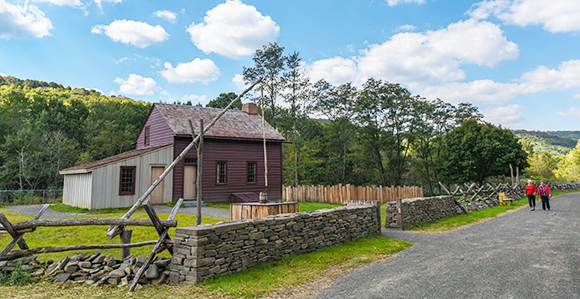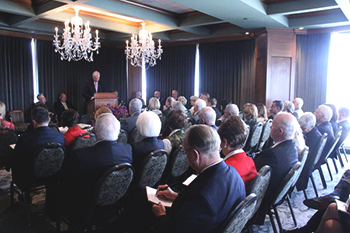Church Historic Sites Reinforce Faith and Help Us Remember
Contributed By Sarah Jane Weaver, Church News associate editor

The rebuilt Joseph Smith home at the Priesthood Restoration Site in Pennsylvania, where key events of the gospel's restoration occurred.
“Being in the Sacred Grove is a much more powerful experience than being taught about the Sacred Grove. Families want to feel the spirit of the places, and parents want their children to remember what others did who went before.” —Elder Steven E. Snow of the Seventy
Related Links
The Church makes a substantial commitment to historic sites because of “the importance of remembering,” said Elder Steven E. Snow of the Seventy.
“Our Heavenly Father is desirous we remember,” said Elder Snow, Church Historian and Recorder and Executive Director of the Church History Department.
Speaking during the 2016 seminar for new missionary training center presidents and directors of visitors’ centers and historic sites, Elder Snow addressed “the spiritual foundation of historic sites.”
Noting that the word “remember” is used 230 times in the Book of Mormon alone, Elder Snow said, “Clearly God desires us to remember His words, His works, and the works of His people. From the very early days of the Church, scribes have kept a record.”
The same records were carefully packed into crates and loaded into wagons when early Church members moved west. But it was several decades after the organization of the Church before any thought was given to the collection, preservation, or sharing of historic sites, he said.

Elder Steven E. Snow of the Seventy and Church Historian and Recorder speaks at the 2016 Seminar for New MIssionary Training Center Presidents and Directors of Visitors' Centers and Historic Sites. Photo by Sarah Jane Weaver.

Elder Steven E. Snow of the Seventy and Church Historian and Recorder speaks at the 2016 Seminar for New MIssionary Training Center Presidents and Directors of Visitors' Centers and Historic Sites. Photo by Sarah Jane Weaver.
“Following the death of President Brigham Young in 1877, the leading brethren of the Church began to realize there were fewer individuals left who had firsthand knowledge of the places where the Saints had settled and worshipped in the early, difficult days of the Church,” said Elder Snow. “Therefore, in 1878 Elder Orson Pratt and Elder Joseph F. Smith were sent east to visit and inventory potentially historically significant places in Church history.”
Because of the financial difficulties and persecution the Church was facing during this time, no historic sites were acquired, explained Elder Snow. However, because of this experience an appreciation for historic sites was instilled in young Joseph F. Smith, which would bear great fruit years later when he became President of the Church.
A decade later, Andrew Jenson, Edward Stevenson, and Joseph F. Black were called on a brief mission in search of historical information. They photographed sites in Nauvoo and the jail in Carthage, Illinois; Kirtland, Ohio; the Joseph Smith Sr. farm and the Grandin Printing Offices in Palmyra, New York; and the jail in Liberty, Missouri, where Joseph Smith and others were imprisoned.
“Not only did they visit the sites; they sought out individuals to interview who had been alive at the time … these events occurred.”
The presidency of Joseph F. Smith ushered in a remarkable time of historic site acquisition for the Church, said Elder Snow. “The historic sites acquired during that time include Carthage Jail (1903); the Independence, Missouri, temple lot (1904); Joseph Smith’s birthplace in Sharon, Vermont (1905); the Smith farm and Sacred Grove (1907); and the Far West temple site (1909).”
In 1902 the Church also designated Temple Square in Salt Lake City as a historic site, he said.
“The 20th-century prophets who followed Joseph F. Smith left their own mark on historic sites, but the first major progress in this area occurred under his administration,” said Elder Snow.
Today Church members are the most numerous visitors to Church historic sites.
“They come for a variety of reasons, but two of the main reasons are to remember what took place there and to reinforce faith. Parents bring their children so they feel the spirit of these sacred places.
“It is one thing to read about a handcart, but quite another to pull a handcart. Being in the Sacred Grove is a much more powerful experience than being taught about the Sacred Grove. Families want to feel the spirit of the places, and parents want their children to remember what others did who went before.
“So in my view it really is about remembering.”
